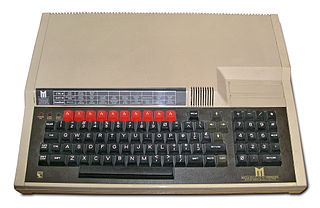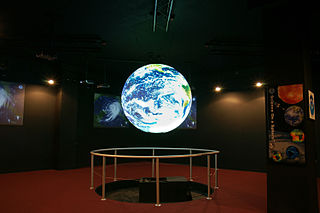
The Apple II is an 8-bit home computer, one of the first highly successful mass-produced microcomputer products, designed primarily by Steve Wozniak. It was introduced in 1977 at the West Coast Computer Faire by Jobs and was the first consumer product sold by Apple Computer, Inc. It is the first model in a series of computers which were produced until Apple IIe production ceased in November 1993. The Apple II marks Apple's first launch of a personal computer aimed at a consumer market – branded towards American households rather than businessmen or computer hobbyists.

Compact disc (CD) is a digital optical disc data storage format that was co-developed by Philips and Sony and released in 1982. The format was originally developed to store and play only sound recordings (CD-DA) but was later adapted for storage of data (CD-ROM). Several other formats were further derived from these, including write-once audio and data storage (CD-R), rewritable media (CD-RW), Video Compact Disc (VCD), Super Video Compact Disc (SVCD), Photo CD, PictureCD, CD-i, and Enhanced Music CD. The first commercially available audio CD player, the Sony CDP-101, was released October 1982 in Japan.

The Commodore 64, also known as the C64 or the CBM 64, is an 8-bit home computer introduced in January 1982 by Commodore International. It has been listed in the Guinness World Records as the highest-selling single computer model of all time, with independent estimates placing the number sold between 10 and 17 million units. Volume production started in early 1982, marketing in August for US$595. Preceded by the Commodore VIC-20 and Commodore PET, the C64 took its name from its 64 kilobytes(65,536 bytes) of RAM. With support for multicolor sprites and a custom chip for waveform generation, the C64 could create superior visuals and audio compared to systems without such custom hardware.

The Philips CD-i is an interactive multimedia CD player developed and marketed by Dutch company Philips, who supported it from December 1991 to late 1998. It was created to provide more functionality than an audio CD player or game console, but at a lower price than a personal computer with a CD-ROM drive. The cost savings were due to the lack of a floppy drive, keyboard, mouse, and monitor, and less operating system software. "CD-i" also refers to the multimedia Compact Disc standard used by the CD-i console, also known as Green Book, which was co-developed by Philips and Sony.

The TurboGrafx-16 Entertainment SuperSystem, known in Japan and France as the PC Engine, is a cartridge based home video game console manufactured and marketed by NEC Home Electronics, and designed by Hudson Soft. It was released in Japan on October 30, 1987 and in the United States on August 29, 1989. It also had a limited release in the United Kingdom and Spain in 1990, known as simply TurboGrafx and based on the American model, while the Japanese model was imported and distributed in France in 1989. It was the first console released in the 16-bit era, although it used an 8-bit CPU. Originally intended to compete with the Nintendo Entertainment System (NES), it ended up competing with the Sega Genesis, and later on the Super Nintendo Entertainment System (SNES).

The 3DO Interactive Multiplayer, often called the 3DO, is a home video game console platform developed by The 3DO Company. Conceived by entrepreneur and Electronic Arts founder Trip Hawkins, the 3DO was not a console manufactured by the company itself, but a series of specifications, originally designed by Dave Needle and R. J. Mical of New Technologies Group, that could be licensed by third parties. Panasonic produced the first models in 1993, and further renditions of the hardware were released in 1994 by GoldStar and in 1995 by Sanyo.

The Atari 8-bit family is a series of 8-bit home computers introduced by Atari, Inc. in 1979 and manufactured until 1992. All of the machines in the family are technically similar and differ primarily in packaging. They are based on the MOS Technology 6502 CPU running at 1.79 MHz, and were the first home computers designed with custom co-processor chips. This architecture enabled graphics and sound capabilities that were more advanced than contemporary machines at the time of release, and gaming on the platform was a major draw. Star Raiders is considered the platform's killer app.

The Commodore PET is a line of home/personal computers produced starting in 1977 by Commodore International. A top-seller in the Canadian and United States educational markets, it was the first personal computer sold to the public and formed the basis for their entire 8-bit product line, including the Commodore 64. The first model, which was named the PET 2001, was presented to the public at the Winter Consumer Electronics Show in 1977.

Defender of the Crown is a strategy computer game designed by Kellyn Beck. It was Cinemaware's first game, and was originally released for the Commodore Amiga in 1986, setting a new standard for graphic quality in home computer games.

FM Towns system is a Japanese variant of PC, built by Fujitsu from February 1989 to the summer of 1997. It started as a proprietary PC variant intended for multimedia applications and PC games, but later became more compatible with regular PCs. In 1993, the FM Towns Marty was released, a game console compatible with existing FM Towns games.
Adobe Shockwave was a multimedia platform for building interactive multimedia applications and video games. Developers originate content using Adobe Director and publish it on the Internet. Such content can be viewed in a web browser on any computer with the Shockwave Player plug-in installed. Macromind originated the technology; Macromedia developed it further, releasing Shockwave Player in 1995. Adobe Systems acquired Shockwave in 2005. Shockwave supports raster graphics, basic vector graphics, 3D graphics, audio, and an embedded scripting language called Lingo.

The BBC Master is a home computer released by Acorn Computers in early 1986. It was designed and built for the British Broadcasting Corporation (BBC) and was the successor to the BBC Micro Model B. The Master 128 remained in production until 1993.

Star Wars: Rebel Assault is a rail shooter video game developed and published by LucasArts for DOS, Apple Macintosh, Sega CD and 3DO Interactive Multiplayer systems, set in the Star Wars universe. Released in 1993, it is the first CD-ROM-only game to be published by LucasArts. The game's story focuses on a young pilot called Rookie One as He or She is trained by, and subsequently fights for, the Rebel Alliance in the Galactic Civil War.

Star Wars: X-Wing is a space simulation video game, the first of the X-Wing combat flight simulator game series. The player's character flies starfighters, including the eponymous X-wing, for the Rebel Alliance as part of a narrative that precedes and parallels the events of Star Wars Episode IV: A New Hope.

A ROM cartridge, usually referred to simply as a cartridge or cart, is a removable memory card containing ROM designed to be connected to a consumer electronics device such as a home computer, video game console and to a lesser extent, electronic musical instruments. ROM cartridges can be used to load software such as video games or other application programs.

The British Broadcasting Corporation Microcomputer System, or BBC Micro, is a series of microcomputers and associated peripherals designed and built by the Acorn Computer company in the 1980s for the BBC Computer Literacy Project, operated by the British Broadcasting Corporation. Designed with an emphasis on education, it was notable for its ruggedness, expandability, and the quality of its operating system. An accompanying 1982 television series, The Computer Programme, featuring Chris Serle learning to use the machine, was also broadcast on BBC 2.

Science On a Sphere (SOS) is a spherical projection system created by NOAA. It presents high-resolution video on a suspended globe rather than a flat screen, with the aim of better representing global phenomena. Animated images of atmospheric storms, climate change, and ocean temperature can be shown on the sphere to explain these complex environmental processes. SOS systems are most frequently installed in science museums, universities, zoos, and research institutions, although new and novel uses for these systems in a variety of presentation spaces and contexts are starting to emerge.

The Amiga CD32, styled Amiga CD32 and code-named "Spellbound", is a 32 bit home video game console developed by Commodore and released in western Europe, Australia, Canada and Brazil. It was first announced at the Science Museum in London on July 16, 1993, and was released in September of the same year.
LV-ROM is an optical disc format developed by Philips Electronics to integrate analog video and computer software for interactive multimedia. The LV-ROM is a specialized variation of the CAV Laserdisc. LV-ROM is an initialism for "LaserVision Read-Only Memory".

Virtual Murder is a four-part murder mystery adventure game series developed by Creative Multimedia Corporation. The games were released in 1993 and 1994 for Macintosh and Windows PCs.






















